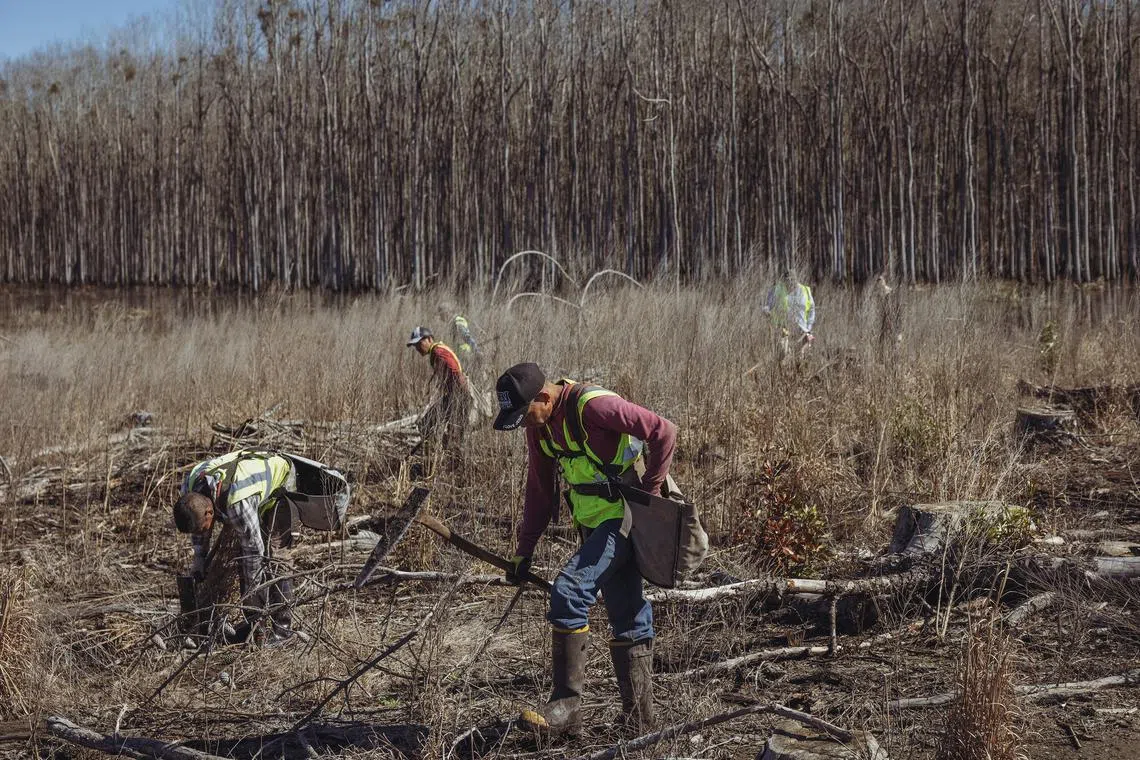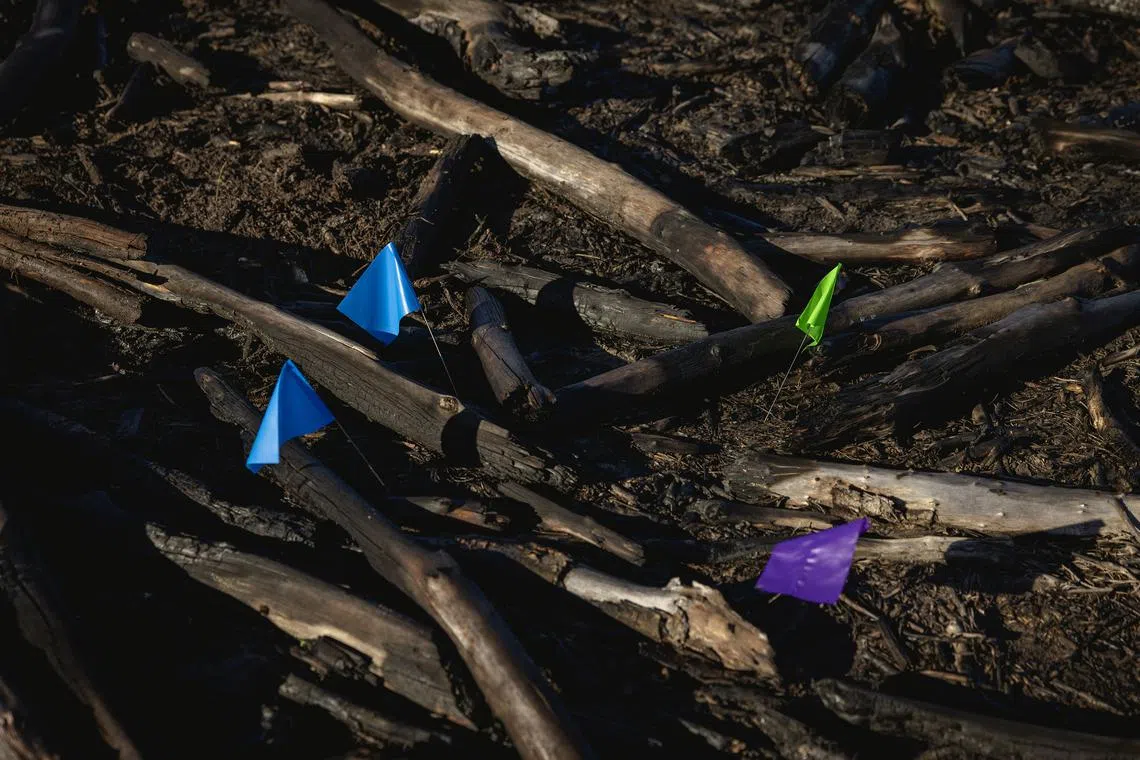Genetically modified trees planted in a US forest for the first time
Sign up now: Get ST's newsletters delivered to your inbox

A hand-planting crew plants poplar trees in Vidalia, Georgia, on Feb 13.
PHOTO: NYTIMES
Follow topic:
WASHINGTON - On Monday, in a low-lying tract of southern Georgia’s pine belt, half a dozen workers planted row upon row of twig-like poplar trees.
These were not just any trees: Some of the seedlings have been genetically engineered to grow wood at turbocharged rates while slurping up carbon dioxide from the air.
The poplars may be the first genetically modified trees planted in the United States outside of a research trial or a commercial fruit orchard. Just as the introduction of the Flavr Savr tomato in 1994 introduced a new industry of genetically modified food crops, the tree planters on Monday hope to transform forestry.
Living Carbon,
“We’ve had people tell us it’s impossible,” Ms Maddie Hall, the company’s co-founder and chief executive, said of her dream to deploy genetic engineering to fight climate change. Despite the naysayers, she and her colleagues have found believers to invest US$36 million (S$48 million) in the four-year-old company.
Critics are slamming the company. The Global Justice Ecology Project, an environmental group, has called the company’s trees “growing threats” to forests and expressed alarm that the federal government allowed them to evade regulation, opening the door to commercial plantings much sooner than is typical for engineered plants.
Living Carbon has yet to publish peer-reviewed papers; its only publicly reported results come from a greenhouse trial that lasted just a few months. These data have some experts intrigued but stopping well short of a full endorsement.
“They have some encouraging results,” said Professor Donald Ort, a University of Illinois geneticist whose plant experiments helped inspire Living Carbon’s technology. But he added that the notion that greenhouse results will translate to success in the real world is “not a slam dunk”.
Living Carbon’s poplars start their lives in a lab in Hayward, California. There, biologists tinker with how the trees conduct photosynthesis, the series of chemical reactions plants use to weave sunlight, water and carbon dioxide into sugars and starches. In doing so, they follow a precedent set by evolution: several times over Earth’s long history, improvements in photosynthesis have enabled plants to ingest enough carbon dioxide to cool the planet substantially.
While photosynthesis has profound impacts on the Earth, as a chemical process it is far from perfect. Numerous inefficiencies prevent plants from capturing and storing more than a small fraction of the solar energy that falls onto their leaves. Those inefficiencies, among other factors, limit how fast trees and other plants grow, and how much carbon dioxide they soak up.
Scientists have spent decades trying to take over where evolution left off. In 2019, Prof Ort and his colleagues announced that they had genetically hacked tobacco plants to photosynthesise more efficiently.
Normally, photosynthesis produces a toxic by-product that a plant must dispose of, wasting energy. The Illinois researchers added genes from pumpkins and green algae to induce tobacco seedlings to instead recycle the toxins into more sugars, producing plants that grew nearly 40 per cent larger.
That same year, Ms Hall, who had been working for Silicon Valley ventures like OpenAI (which was responsible for the language model ChatGPT), met her future co-founder Patrick Mellor at a climate tech conference. Mr Mellor was researching whether trees could be engineered to produce decay-resistant wood.

A hand-planting crew loading a truck in Vidalia, Georgia, on Feb 13.
PHOTO: NYTIMES
With money raised from venture capital firms and Ms Hall’s contacts in the tech world, including OpenAI chief executive Sam Altman, she and Mr Mellor started Living Carbon in a bid to juice up trees to fight climate change. “There were so few companies that were looking at large-scale carbon removal in a way that married frontier science and large-scale commercial deployment,” Ms Hall said.
In a field accustomed to glacial progress and heavy regulation, Living Carbon has moved fast and freely. The genetically modified poplars avoided a set of federal regulations of such organisms that can stall biotech projects for years.
In contrast, a team of scientists who genetically engineered a blight-resistant chestnut tree using the same bacterium method employed earlier by Living Carbon have been awaiting a decision since 2020. An engineered apple grown on a small scale in Washington state took several years to be approved.
Those regulations have since been revised.
“You could say the old rule was sort of leaky,” said Mr Bill Doley, a consultant who helped manage the US Agriculture Department’s genetically modified organism regulation process until 2022.
On Monday, on the land of Mr Vince Stanley, a seventh-generation farmer who manages more than 10ha of forests in Georgia’s pine belt, workers carrying backpacks of seedlings planted nearly 5,000 modified poplars. The tweaked poplars had names like Kookaburra and Baboon, which indicated which “parent” tree they were cloned from, and were interspersed with a roughly equal number of unmodified trees.
In contrast to fast-growing pines, hardwoods that grow in bottomlands like these produce wood so slowly that a landowner might get only one harvest in a lifetime, Mr Stanley said. He hopes Living Carbon’s “elite seedlings” will allow him to grow bottomland trees and make money faster.
“We’re taking a timber rotation of 50 to 60 years, and we’re cutting that in half,” he said. “It’s totally a win-win.”

Poplar seedlings are color-coded after being planted in Vidalia, Georgia, on Feb 13.
PHOTO: NYTIMES
Forest geneticists were less sanguine about Living Carbon’s trees. Researchers typically assess trees in confined field trials before moving to large-scale plantings, said Dr Andrew Newhouse, who directs the engineered chestnut project at the State University of New York’s College of Environmental Science and Forestry. “Their claims seem bold based on very limited real-world data,” he said.
Professor Steve Strauss, a geneticist at Oregon State University, agreed with the need to see field data. “My experience over the years is that the greenhouse means almost nothing” about the outdoor prospects of trees whose physiology has been modified, he said. “Venture capitalists may not know that.”
The US Forest Service, which plants large numbers of trees every year, has said little about whether it would use engineered trees.
To be considered for planting in national forests, which make up nearly one-fifth of US forestland, Living Carbon’s trees would need to align with existing management plans that typically prioritise forest health and diversity over reducing the amount of atmospheric carbon, said Dr Dana Nelson, a geneticist with the service. “I find it hard to imagine that it would be a good fit on a national forest,” Dr Nelson said.
Living Carbon is focusing for now on private land, where it will face fewer hurdles. Later this spring, it will plant poplars on abandoned coal mines in Pennsylvania. By next year, Ms Hall and Mr Mellor hope to be putting millions of trees in the ground. NYTIMES

